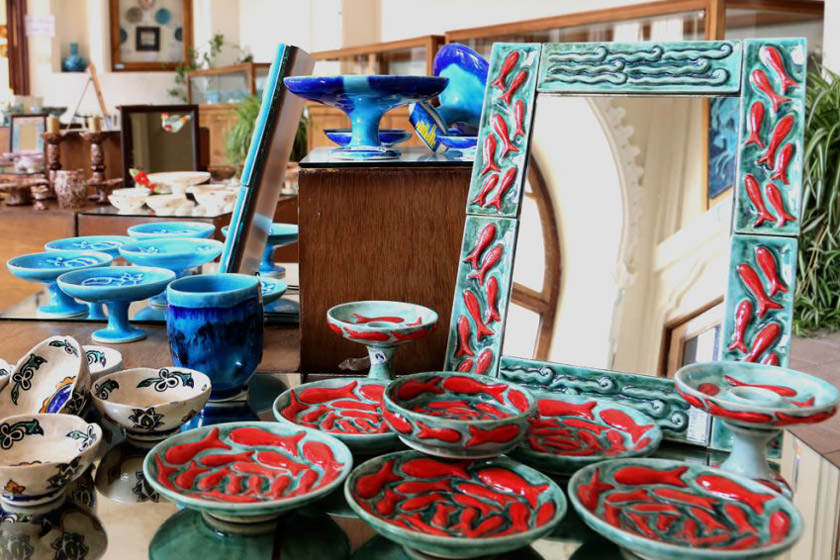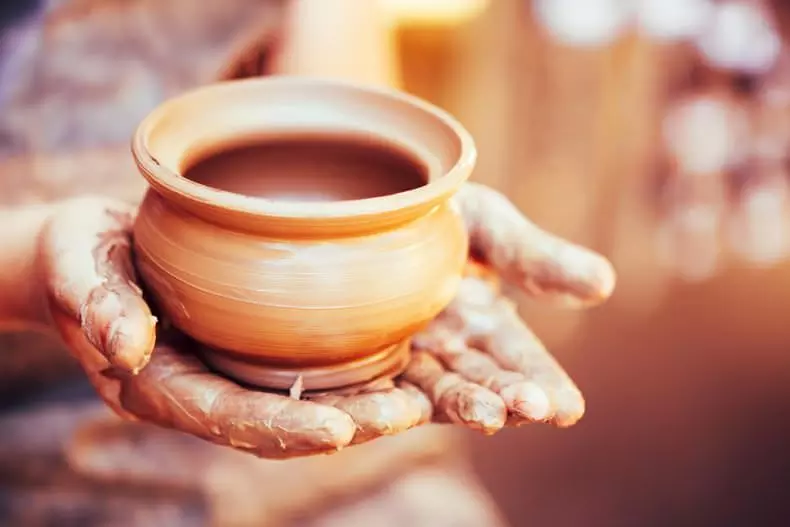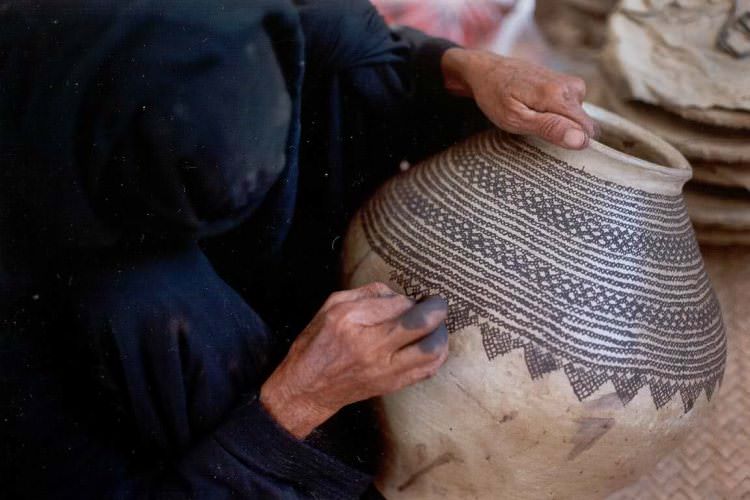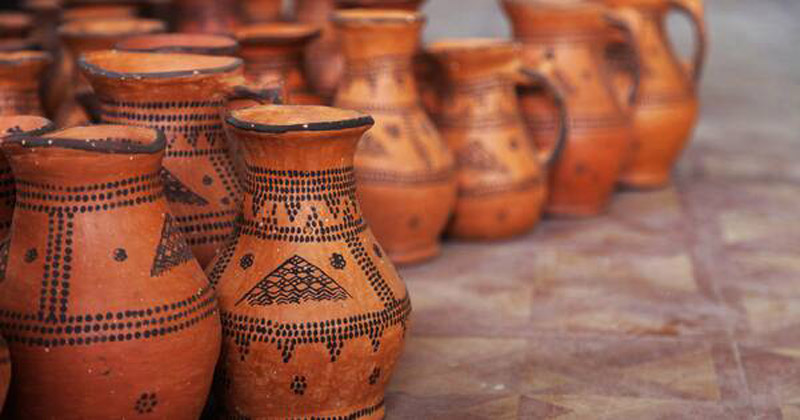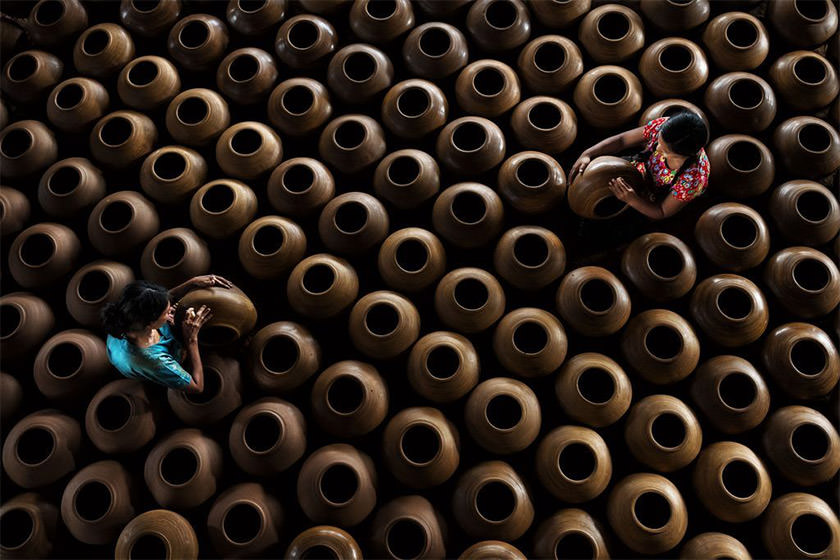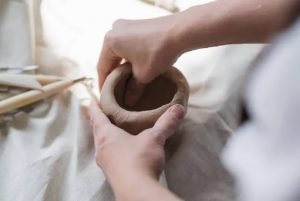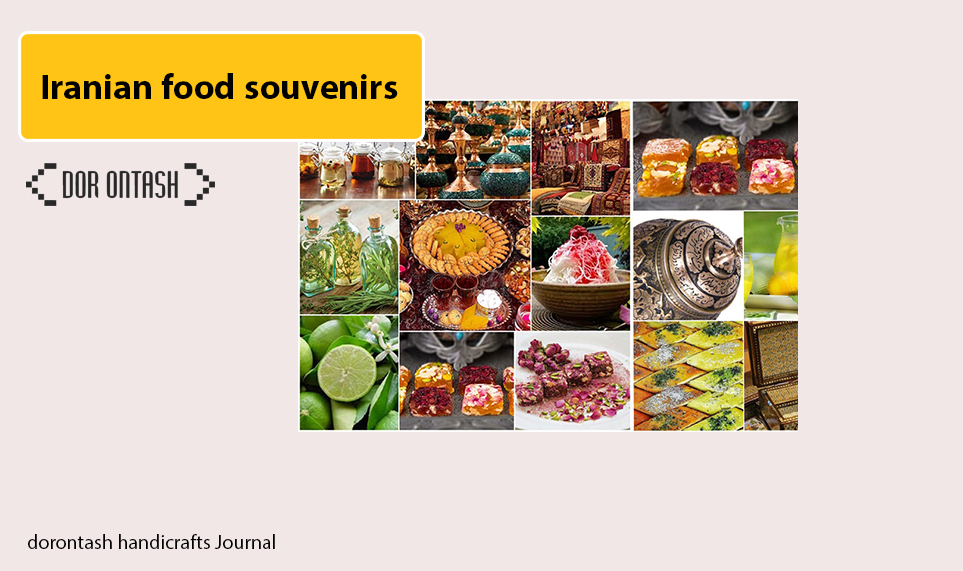Undoubtedly, one of the oldest human arts and handicrafts is the art of pottery, which in some cases have even been determined by the discovery of examples of its antiquity and civilizational background. The first examples of pottery date back to 8000 BC, which were made without the use of a wheel and were baked over a fire without an oven.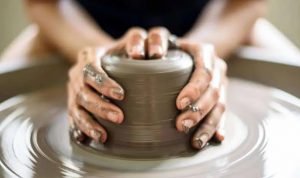
Between 6000 and 4000 BC, the first pottery wheel was invented in Mesopotamia. This revolutionized the way ancient people could make objects from clay. Potters were no longer limited to the lengthy process of hand molding clay – they could have more freedom to experiment with new forms and aesthetics.
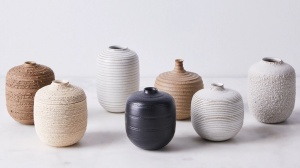
While pottery has always had inherent artistic qualities, the process changed even more when the pottery wheel was introduced. Instead of serving utilitarian purposes, it now served artistic purposes. While the earliest items found by archaeologists were generally undecorated, unglazed, and hand-shaped pottery, by 6,000 BC, places such as the Middle East, China, and Europe had developed a wide range of design techniques.
From intricate painted designs that chronicled the pharaoh’s reign to highly polished bowls and plates to intricate animal sculptures, thanks to the invention of the potter’s wheel, ceramists achieved remarkable skill and ability never seen before.
video of The art of pottery

If you want to know more about this unique and ancient practice and how it became the industry it is today, we have prepared this guide for you. So, let’s get started – here’s the ultimate guide to pottery history!
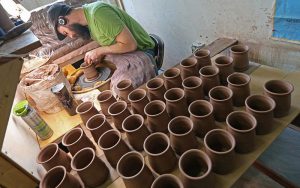
1. What is The art of pottery?
Before we get into the history of pottery, let’s actually define what pottery is and how it is made.
Pottery consists of ceramic materials and includes the main types of pottery such as pottery, stoneware and porcelain. For a piece to be considered pottery, it must have been a fired ceramic vessel that contained clay when formed.
To create a piece of pottery, the potter must mold a ceramic/clay body into a specific object, either by hand or wheel-throwing, and then heat it at a high temperature in a kiln to expel water from the clay. . This allows for modifications to the molded object, increasing its strength and durability while permanently adjusting its shape.
The potter can decorate the clay body before or after firing, however, some processes require certain preparation steps to be taken in order to successfully create a piece of work. Kneading, a process that involves massaging the clay with your hands, allows the moisture in the clay to spread throughout the slab. When the clay is done correctly, it will have the same moisture and you are one step away from creation.
The next preparation method when working with clay is called airing. This is done either by a vacuum machine attached to the pug mill or manually through a wedging process. Once the clay is aerated and dehumidified, it is ready to be shaped in a variety of ways. Once formed, it is dried and then baked.
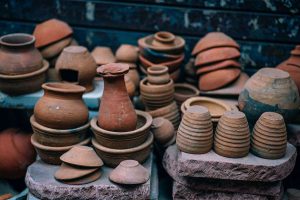
2. Why did pottery resonate so much among people?
Pottery has been around since ancient peoples roamed the earth. As one of the oldest human inventions, pottery has developed alongside civilization. The oldest ceramic objects date back to 29,000 years BC. One of the most popular pieces from this time period is the Dolni Vestonice Venus discovered in the Czech Republic, a ceramic Venus of a nude woman.
Because clay is found almost everywhere, early humans had easy access to this responsive material, allowing them to mold and shape the world they observed around them. With limited access to tools, clay also allows these people to mold and shape by hand and make human figurines, bowls, dishes, and more.
Once early humans developed fire, they realized that heating these clay objects transformed them into a different material that was permanent and much more useful to them—mainly items such as bowls, plates, and containers for storage and preparation. Food.
As civilization has progressed further, pottery has always progressed alongside it, even helping people survive and providing them with a higher standard of living.
For example, about 21,000 years ago, people in East Asia experienced an extremely cold climate for a long period of time. These ancient peoples had to obtain the maximum caloric and nutritional value from their food in order to survive. Pottery was the solution. By creating pots, they can cook their own food and improve nutrient intake from starchy plants and meat, common foods in the region.
Pottery has been revered throughout history for its many useful uses. Of course, over the centuries, it has evolved into more than just functional ceramic items.
3. When did pottery production change?
When buying handicrafts, do you pay attention to the history and age of that art? Undoubtedly, knowing the history of handicrafts tells us the value of those products. In this article, we have tried to describe the history and stages of pottery art.
Between 6000 and 4000 BC, the first pottery wheel was invented in Mesopotamia. This revolutionized the way ancient people could make objects from clay. Potters were no longer limited to the lengthy process of hand molding clay – they could have more freedom to experiment with new forms and aesthetics.
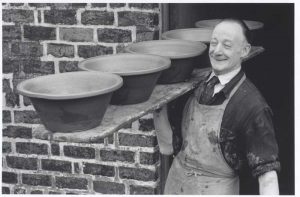
While pottery has always had inherent artistic qualities, when the potter’s wheel came along, it changed the game! Instead of serving primarily utilitarian purposes, it branched out into artistic expression. While the earliest items found by archaeologists were generally undecorated, unglazed, and hand-shaped pottery, by 6,000 BC, places such as the Middle East, China, and Europe had developed a wide range of design techniques.
From intricate painted designs that chronicled the pharaoh’s reign to highly polished bowls and plates to elaborate animal figures, thanks to the invention of the potter’s wheel, ceramists achieved remarkable skill and ability never seen before.
4. How did potter’s wheels turn before electricity?
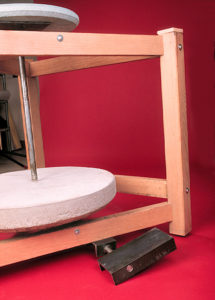

The first mechanical potter’s wheel wasn’t invented until the 19th century, so the first manual potter’s wheel was truly a lasting innovation.
There are many ways to work with a potter’s wheel without electricity. Most of the time, in ancient times, clay wheels were turned by hand and the user kicked them with their feet to move them. Other ways to turn a potter’s wheel include using a stick inserted into a hole in the top of the wheel and then turning it or simply speeding it up by hand.
Once the mechanical wheel was invented, potters could start producing multiple items per hour, revolutionizing the industry once again!
5. How has pottery making changed in the last 100 years?
Pottery has changed a lot since the early days of handmade ceramic bowls and wheelbarrows. The biggest change in the last 100 years has to do with the kiln, another essential tool of the pottery trade. As potter’s wheels became electrified, so did kilns from gas to electricity. Even in the past 20 years, innovators in the furnace industry have advanced and developed electronic programmers to control furnace temperature and power.

When it comes to industrial production, fired ceramic vessels have moved from jigger to press. Jigging is a mechanical adaptation of wheel throwing and is used in cases where mass production or reproduction of the same shape is required, such as bowls and plates. Pressing, on the other hand, involves placing a ceramic slab against a mold plate to achieve a custom look.
And some of the biggest innovators in the pottery industry today are taking a technology-focused approach. Most of the production lines in the main production facilities have been automated to reduce manpower while increasing machine automation.
6. What do you think is the biggest advantage of pottery production?
Pottery is one of the most enduring art forms, with many fragments found throughout the world from almost all time periods and civilizations. There is no doubt that ceramic items last much longer than other artifacts made from less durable materials. When a person makes a piece of pottery, they probably consider its lasting quality and what it means to find something made by their hands millennia later – something that interests many who learn the craft. inspires
At Deneen Pottery studios, many of the resident potters say it’s the reason they got into the business in the first place. When asked about the longevity of this unique medium, Texas Tina, Art Director Deneen Pottery said, “I think about it often, especially when I’m designing a ceramic mug with a historic building on it. “There may come a time when our only glass is the only reproduction of that building.”
7. What is the most exciting thing that has happened to pottery in the last five years?
Thanks to the intersection of pottery customization, marketing, and affordability, more and more people are snapping up custom-designed items, like branded coffee mugs. From companies and non-profit organizations to museums and monuments, even events. Everyone wants to take advantage of the many benefits that a custom designed mug has to offer, making it a top seller for pottery companies around the world.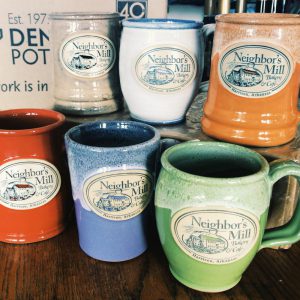
8. What does the future of pottery hold?
Throughout the development of civilization, people have relied on pottery to improve their way of life. This should not change much in the near future. People will always have the same need for pottery as they always have, whether for functional or artistic purposes. From a potter’s perspective, the need for pottery is not being met by US-based manufacturers because, due to intense competition from low-cost imports, many manufacturers are either in-house or outsourcing their production facilities to cut costs or close.
As for Deneen Pottery, we believe we have a bright future and a confident outlook because our product is more than a simple utility piece. Our work has aspects of fine art that depict signs of places and events that people want to take home with them to make a special memory in their lives. We are committed to preserving our customer’s memories for years, centuries, even millennia (okay, maybe just a few pieces for that last one).
How to start!
Create pottery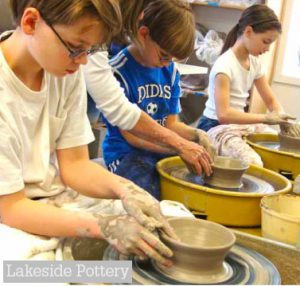
Making pottery for beginners can be an enjoyable, therapeutic and relatively easy hobby. Almost anyone can develop their skills as a potter with the right tools, techniques and inspiration.
You should never be afraid to start making beautiful, thrown or handmade pottery just because you are a beginner. If you want to learn this art, we have prepared this guide for you. So let’s get started – here’s the ultimate guide on how to get started with pottery!
Pottery for Beginners: Basic Pottery Making Techniques
Pottery steps
In this article, we are going to explain the steps of pottery in full for you, dear users.
Because knowing it will be interesting and attractive for you dear ones who are even a little interested in this art.
Guide us to go through the steps of pottery together.
At the beginning, we must know the tools needed for pottery:
The most important thing you need to do the different stages of pottery is clay.
For small pottery projects, you can get ready-made clay.
Tools needed in pottery stages: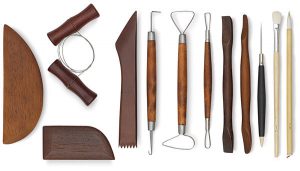
- needle
- leather
- Knife
- a handful
- spatula
- sponge
- brush
- spatula
- cut the wire
Pottery steps
The first step: preparing the rose flower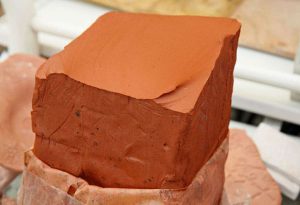
The mud used in pottery is composed of clay and water.
When performing the pottery process : When adding water to the clay, great care must be taken to prepare a suitable mud that is neither too thin nor too thick.
Because both thin mud and thick mud do not have enough strength.
Complete kneading of rosin
Remember that after mixing the clay with water, the mud produced must be sufficiently kneaded.
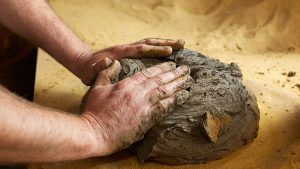 Knead the flower like pastry dough and punch it on top
Knead the flower like pastry dough and punch it on top
Beat to get rid of air bubbles that are layered with mud particles.
Shaping the clay
One of the most important stages of pottery is shaping the clay.
When the clay has been sufficiently kneaded and the clay has reached a sufficient consistency, start shaping the clay.
Pottery method without wheel
You can shape the prepared flower using both wheelless and wheeled pottery methods.
In the wheelless pottery method , which includes 3 methods {pressure, wick and plate}, you can easily prepare simple dishes or sculptures.
Pottery with a wheel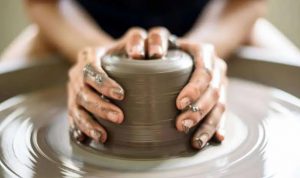
Pottery with a wheel requires more skill and with this method you can create more complex vessels and works of art beautifully.
Cooking a prepared clay pot
When the desired clay pot is ready, it is time to cook and dry it.
At this stage of pottery making, first make sure that the target vessel is almost dry, then put it in the kiln.
The last step of the pottery process
The glaze is baked on a clay pot: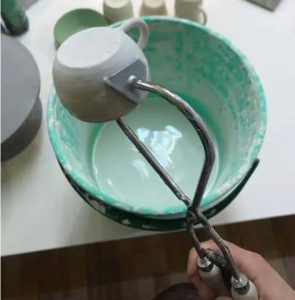
To make the prepared clay dish more beautiful, it is coated with glaze.
Since the glaze is fluid, as a result, before this step:
coat the bottom of the clay pot with wax to prevent the pot from sticking to the oven.
Painting a clay pot:
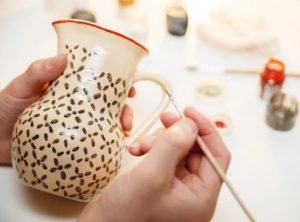 You can paint the dish first and then cover it with clear glaze. If you feel that the surface of the dish you made is not smooth, smooth it using sandpaper. Then wipe the dust on the container with a wet sponge .
You can paint the dish first and then cover it with clear glaze. If you feel that the surface of the dish you made is not smooth, smooth it using sandpaper. Then wipe the dust on the container with a wet sponge .
Types of pottery
Now that you know the two main techniques for creating pottery, let’s take a look at the materials you’ll need. First and foremost is the type of clay used. In general, clay can be classified as pottery, stoneware, or porcelain.
Pottery is made from fired clay and often finished in a glaze. Because earthenware is a porous material, it can crack if exposed to water or heat, such as in a dishwasher.
Stoneware (which is what we use) is one of the most popular pottery materials for making dinnerware because it is impervious to liquid and heat. While it is hard like porcelain, it is opaque like earthenware and is available in white to tan, red, and mottled colors. The exact composition of stoneware clay can also vary greatly, and depending on the region or the recipe you are following, the consistency can range from smooth (low impurities) to coarse (high additives). Feel the bottom of any pot and you’ll know what we’re talking about. Every mug we make is silky smooth, meaning we use the purest, select clay we can find.
Porcelain is very similar to glass and performs best with a dialed firing process that ensures the required firing temperature is achieved. We do not recommend starting with these materials. It is best to brush up on your skills in earthenware or stoneware before moving on to porcelain.
Pottery for Beginners: Basic Equipment Needed
Beginning potters need to know the different techniques and materials used to create pottery, as well as the pottery equipment required to achieve different shapes.
Pottery kiln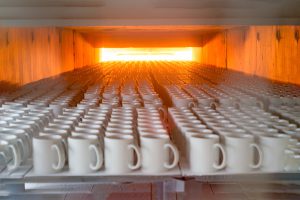
The main piece of equipment you’ll need to kick off your pottery hobby is a kiln—a simple device for firing and firing the glaze on pottery. The main reason you want a kiln is to chemically convert the clay into a permanent lasting effect. While not necessary for smaller pieces that don’t come into contact with water, it is necessary to create pieces that you want to use, such as dinnerware, cups, or vases.
Professional potters typically use a combination of firing and kiln processes, including commercial wood, gas, and electric kilns. As a beginner, you’ll likely stick with an electric-powered “hobby” grill that maxes out at around 2,340 degrees Fahrenheit, which should have easy temperature controls and an easy-to-use manual.
Small furnaces simply plug into a standard wall outlet, while larger furnaces may need to be wired by a professional electrician and require specialized service. In terms of cost, you can expect to pay a few hundred dollars for a compact or used model and up to several thousand dollars for a larger furnace.
Skutt grills are a great option for beginners as they come in a wide range of sizes that all provide high quality fire. One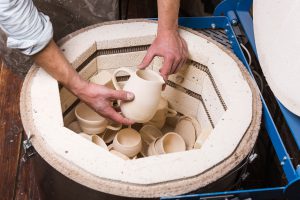 A good choice for a new potter is the Skutt 714 kiln. This kiln has all the features of a larger potter, with a more compact size. This oven has a capacity of 14 x 14 inches and weighs less than 100 pounds, making it compact enough for a home studio. Learn more about this oven and see other sizes here
A good choice for a new potter is the Skutt 714 kiln. This kiln has all the features of a larger potter, with a more compact size. This oven has a capacity of 14 x 14 inches and weighs less than 100 pounds, making it compact enough for a home studio. Learn more about this oven and see other sizes here
pottery wheel
If you are interested in making more advanced ceramic pieces, you should invest in a pottery wheel. These wheels are available in two types, electric and manual, both of which have different advantages and disadvantages.
For a beginner, producing pottery on a small electric wheel is a good choice because it does not require coordination to hit the wheel while forming a shape. These also provide greater torque and speed control for clay handling. We use Brent wheels in our studio and they are great for both the beginner and the production potter. Parts are easy enough to replace and we can verify that a wheel can easily make over 500,000 glasses before needing a repair.
On the other hand, manually operated wheels can give the user more control than electric wheels. This is because the potter has complete control over the speed of the wheel by how much he kicks the wheel with his feet.
Clay modeling base
If you are sticking to the handmade method of making pottery, a pottery molding stand will come in handy. Although not a single piece of equipment is required, it makes the creation process easier. The potter simply places his slab of clay on this raised, fully rotating surface, simplifying its shaping.
The main tool used
While the above equipment is very important, you also need a variety of special tools to make your desired piece of pottery. Not many are needed right away – in fact, your hands are the main tools you’ll be using throughout the process. However, there are a few things that can make the process easier, more efficient, and help you expand your abilities at the same time.
Pottery Tools for Beginners Pottery Tools – The Ultimate Guide to Pottery
Apron and Towel – Pottery is a very messy art form. Don’t ruin your clothes and keep your hands clean with an apron and towel.
Sponges – These versatile tools come in handy when working on the pottery wheel. Sponges help absorb or distribute water during throwing, making it easier to mold and shape the clay. A sponge attached to an extender can help remove or distribute water to and from hard-to-reach areas.
Wire – You will need a thin piece of wire to remove the piece of pottery from the wheel after it is finished. The wire is usually nylon or metal with wooden notches at each end for the user to hold.
Ribs and Scrapers – These handy tools help shape and smooth the pottery as it is shaped on the wheel. They can also be used in the rib and hand technique used in coiled pottery.
Potter’s Needles – These specialized pottery tools look like long needles and are suitable for a variety of uses, such as cutting wheel rims or cutting clay slabs for hand throwing applications.
Curved Knives – Available in soft or hard, these knives can be used to achieve desired angled and curved cuts. Soft-edged knives are flexible and can be bent into different shapes, while hard-edged knives are more inflexible and better for clean, straight cuts.
Chamomile Leather – These tools are great for smoothing the edges of vases or pressing the edges of thrown containers.
Ring, Wire and Ribbon Tools – A set of these tools gives you versatility when trimming clay plates, especially when hand molding clay.
Brush – Great for when you’re trying to carry water and slide into certain areas when molding clay. You also need a brush to apply any color, underglaze or overglaze.
Wood Modeling Tools – Wood modeling tools come in a wide variety of shapes and are useful for a variety of hand-casting applications.
glaze
Pottery glaze not only gives the piece a better appearance, but also seals the pottery and protects it from water and heat damage. After the pottery goes through its initial firing stage to dry the piece, it is glazed and put back into the kiln for the second firing. The glaze material melts and adheres to the pottery, providing protection, waterproofing and more beauty to the piece.
Glazes are usually in three types of feathers
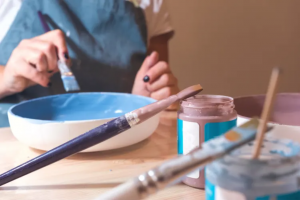
They are opaque, matte and glossy. In general, the gloss finish is used for earthenware such as dinnerware because it is shiny, easy to clean, and non-porous. Matte, without shimmer, is generally used to create a more subdued and sophisticated look. Matte simply describes a glaze that cannot be seen through, thus covering the surface and color of the clay. Of course, not all pottery requires glazing, for example, flower pots may be made without glazing.
These different glazes have subcategories such as semi-transparent, semi-glossy and semi-matte. You should test a few to find out which style you prefer.
Glazes come in literally thousands of combinations of colors, textures, styles, and varieties that can be applied in a variety of ways and fired at a wide range of temperatures. Some glazes may have a vivid color, but still have aspects of the clay underneath. For example, you can use mottled clay and clear glaze, which can create an interesting and unique look.
We’ve found it’s best to keep the oven’s firing cycle constant so you can play around with different glaze recipes. Today we have over 170 different glaze combinations from 39 separate solid glazes from our original recipe invented in 1972. Each color is formulated and mixed from scratch and has a high shine.
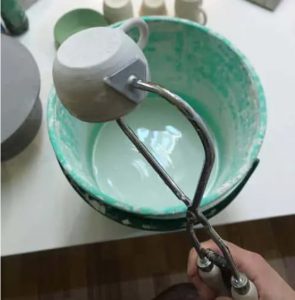
We recommend starting with pre-made glazes that are designed to give you consistent results with a variety of temperatures, methods and firing types. Continental Clay at Stinson in Minneapolis is a wonderful resource! There are also many options for making glazes by purchasing the powder from a ceramic supplier or your local art store. When buying your first glaze, it’s important to read the temperature – the firing temperature should match your clay and be within the range of your kiln.
Everyone can enjoy this fun hobby – so what are you waiting for? Now that you know how to start making pottery, you can try it yourself! Just because you’re new to the craft doesn’t mean you can’t make beautiful and functional clay pieces. All you need is the right knowledge, tools and inspiration to help. Good luck with your first piece of clay!
Types of pottery
Pottery is one of the oldest and most widespread decorative arts. As such, there is much to learn about the art form and the practice of creating beautiful and functional pottery.
Deneen Pottery has created this guide to inform you about the different types of pottery. Lets start!
Three types of pottery are commonly accepted, including earthenware, porcelain, and stoneware.
clay pot
Earthenware is usually fired at a lower temperature than the other two categories, from clay dug from the ground. If it is not glazed, it absorbs water and does not allow light to pass through it. The color of the clay depends on the clay you use, usually clay, brown or reddish.
Due to the natural water absorption properties, the fired object is coated with finely ground glass powder suspended in water and then fired a second time. During firing, the tiny particles that cover the surface fuse into a protective glass-like layer known as the clay body, making the piece waterproof.
A modern clay recipe might include: 25% ball clay, 25% china clay, 35% flint, 15% china stone. The temperature of the first baking or biscuit is 1100-1150 degrees Celsius and the second one is 1050-1100 degrees Celsius.
Traditionally, earthenware is the most common type of pottery among ancient, medieval, Middle Eastern and European cultures, and is still one of the most popular types of pottery today.
Chinese pottery
Porcelain is made from a mixture of materials, generally china clay (kaolin) and china stone (petuntse).
There are three types of porcelain:
- Hard paste – A ceramic material originally made from a mixture of petunce feldspathic rock and kaolin fired at a very high temperature, usually around 1400°C.
- Soft paste – produced by mixing white clay with “ferrite” – a glassy substance that was a mixture of white sand, gypsum, soda, salt, alum and nitre. Lime and chalk are used to melt the white, fried clay, then the mixture is fired at a lower temperature than hard china paste.
- Bone china – a type of soft paste porcelain made from bone ash, feldspathic material and kaolin. Bone fold has a clear body that contains at least 30% phosphate derived from animal bone and calculated calcium phosphate.
Porcelain originated in China. The reason is that it is usually called “China”. Porcelain is a white-bodied, fine-grained vitreous earthenware that is usually translucent and is distinguished from coarser, opaque, porous earthenware.
In the East, porcelain is defined as clay that resonates when struck. In the West, it is a substance that is transparent when held up to light. Neither of these two definitions can cover every piece of porcelain, as some heavy-glazed porcelain is opaque, while some thin-glazed stoneware is somewhat translucent.
stoneware
Stoneware is made from clay, but fired at a higher temperature than clay. The temperature is high enough to partially freeze the material and make the container impervious to liquids even if unglazed. Since stoneware does not absorb water, there is no need to use a glaze from the potter—glazes are purely for aesthetic purposes.
Dark colored stoneware is made from buffalo, brown and red clay without any additives. Most of the current glazed stoneware is salt glazed.
A modern stone recipe might include: 25% ball clay, 25% china clay, 35% flint, 15% china stone. Baking: 1200 to 1300 degrees Celsius. Usually there is only one firing, but if a glaze firing is required it will be at about 1050°C.
Stoneware was made by the Chinese in ancient times and became known in Northern Europe after the Renaissance (14th to 17th centuries).
Classification of pottery
Beyond these three main types of pottery, there are different categories of pottery among the main forms of pottery. These include shapes such as cream and biscuit dishes, including:
Agate pottery
Agate pottery is made by mixing colored clays or by mixing different slip colors. The clays are stacked in slabs and then pounded to form a single mass in which the colors blend indistinctly.
Basalt pottery
Sometimes called black basalt, this type of pottery is a hard black glassy stoneware, named after the volcanic basalt rock, made by the English potter Josiah Wedgwood in the late 16th century.
Bisco pottery
“Bisque” or “biscuit” porcelain is simply a body that has been fired once and has no added glaze. Because it is fired only once, no chemically bonded water remains in the clay. Bisco is a real ceramic material and has a natural and “unfinished” beauty.
Cauliflower pot
Cauliflower pottery is made of cream ware that is modeled and glazed in green and yellow colors to simulate the appearance of cauliflower. This classification also includes other forms of potted fruit or vegetables.
Pottery cream containers
This popular form of pottery includes cream-colored English earthenware, which was prominent in the second half of the 18th century. Staffordshire potters were experimenting with substitutes for Chinese porcelain, and in 1750 they produced a fine white ware with a rich yellow glaze. The clean-glazed light body was ideal for homeware due to its sharp appearance and more affordable price.
Delft pottery
Delft ware is a blue and white earthenware with a tin glaze, first made in Delft, Holland in the early 17th century, and subsequently produced in Holland and England. Delftware includes earthenware of all descriptions, such as plates, ornaments and tiles.
Flambé pottery
Flambé pottery consists of a distinctive glaze. The glaze is deep red and cut with streaks of purple and turquoise and is used to decorate pottery, especially porcelain.
Jasper pottery
Introduced by Josiah Wedgwood, jasper is a type of fine-grained, unglazed stoneware. It was developed in 1775 and resulted from a long series of experiments aimed at discovering porcelain manufacturing techniques. It gets its name from the fact that it resembles natural jasper in its final form.
Majolica pottery
Majolica is a general term for glazed pottery with an opaque tin glaze that completely covers the color of the pottery body. It has been built since the 14th century.
Marble pottery
Marble pottery is made from a combination of different colors of clay to imitate natural marble or agate materials. This form of pottery has been around since at least the first century AD, and artifacts have been recovered all the way from Rome to China.
Pate-sur-Pate pottery
Literally translated as “dough on dough”, this painstaking process involves building a piece of pottery with layers of liquid slip, each of which must be dried before the next is applied until a prominent decoration is formed.
Pearl pottery
Pearlware is perhaps Josiah Wedgwood’s greatest contribution to European ceramics. This form of pottery has very pale cream ware with a bluish glaze.
REDWARE POTTERY
This one is pretty simple – as the name suggests, red terracotta refers to red earthenware that is usually finished unglazed.
Salt glazed pottery
Salt glaze is usually used for all kinds of ceramic pottery. Salt glaze on stoneware is created by pouring common salt into the kiln at its hottest temperature to create a textured effect. The sodium from the salt combines with the silica in the clay and forms a glass coating of sodium silicate.
Slippery pottery
This type of pottery was the main decorative style in the 17th and 18th centuries before glazes became available to the public. Clay pots are decorated with color slip and then glazed.
Clay dishes
Sometimes called sponge ware, earthenware refers to a broad class of pottery decorated with paint that appears to have been sprayed or sponged onto the piece.
Tortoise pottery
Tortoiseshell pottery is a decorative technique applied to pottery that gives the finished piece a unique textured effect.
Transitional pottery
Transfer printing is a process in which a pattern or design is engraved on a copper (or other metal) plate. Then the page is inked and the pattern is “transferred” to a special napkin. The composite texture is then glazed and re-fired on the pre-fired ceramic items.
At first, patterns were transferred to ceramic items after glazing, but the ink was often lost, so “printing” was born. Transitional items have a clear, almost reversible appearance. If you look closely, you can often see where the transition plan ends. Often these are areas where the pattern doesn’t quite match, such as wallpaper.
